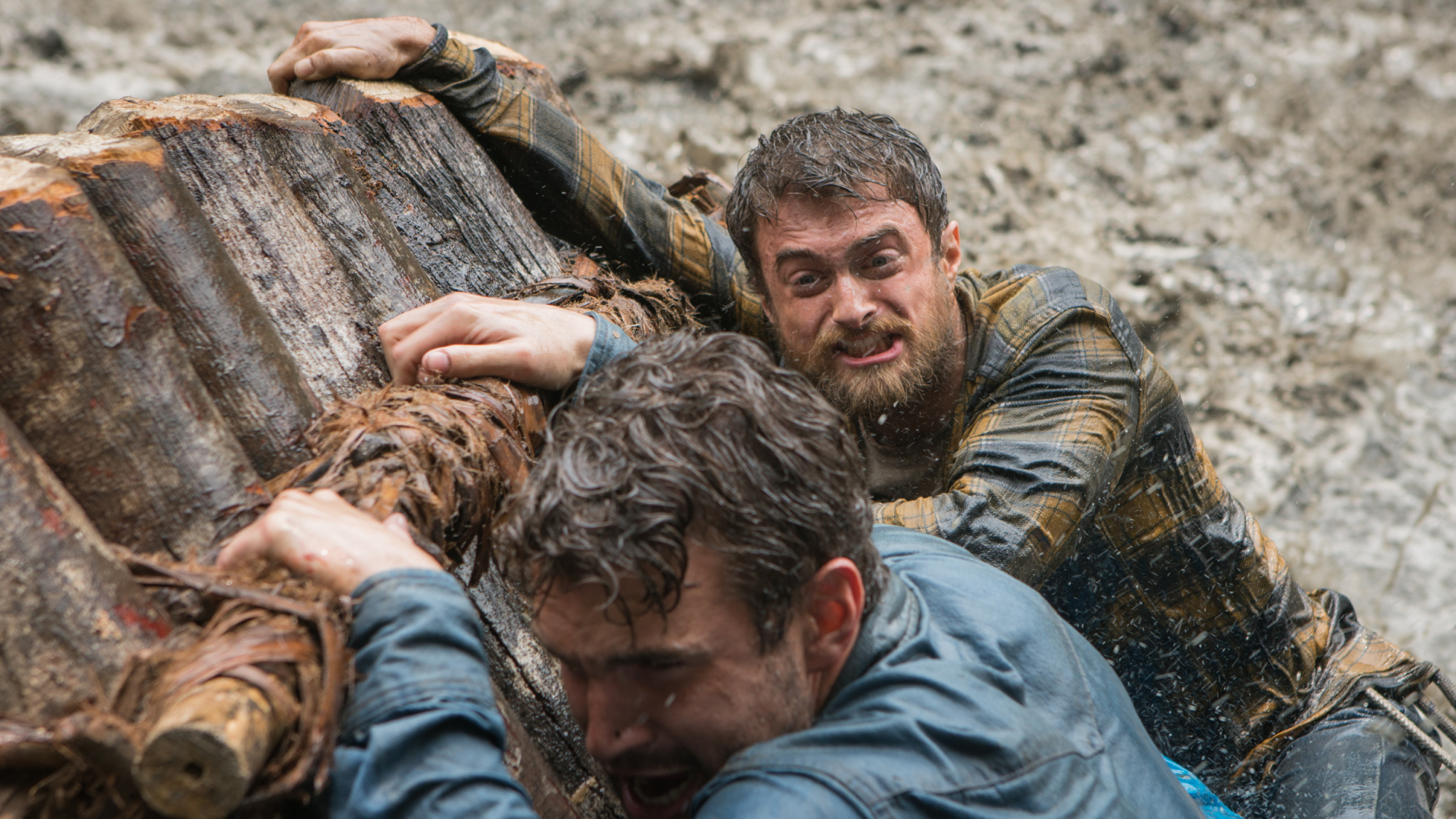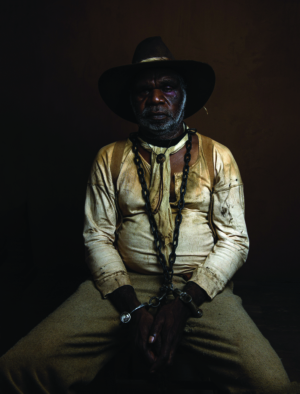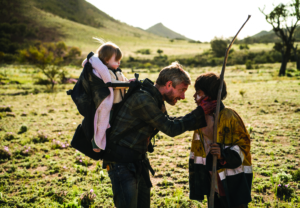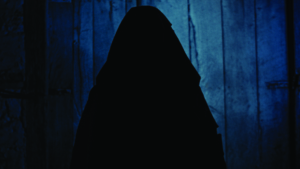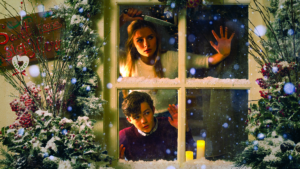The poster for Jungle (Greg McLean, 2017) features actor Daniel Radcliffe with a shaggy beard, wearing a soaked-through flannel shirt and brandishing a machete, surrounded by Amazon greenery and mist. ‘Nature has only one law – survival’, reads the tagline. As film posters go, this is a lot. It’s hardly a new concept to market a film, especially one with horror and thriller elements, in a way that is somewhat misleading, but bless Jungle’s team for trying. The finished product isn’t as savage as that slice of imagery may suggest, but, if there’s one element Australian film marketing needs, it’s chutzpah.
The thing is, Jungle doesn’t actually aspire to be the sort of movie that audiences might expect from a Greg McLean film about a bunch of people stuck in the Amazon. Unfortunately, while I’m fairly certain of what this film doesn’t want to be, I’m not entirely sure what it actually does. Is it a rollicking adventure tale? A gory descent into horror? A film about spiritual discovery? At various times, it seems to be all of these, occasionally recalling an Indiana Jones exploit if he had no discernible skills to get out of life-threatening situations alive. At times, McLean’s film goes admirably small; at others, it swings on big set pieces. I was at least thankful Jungle didn’t descend into predictable Cannibal Holocaust (Ruggero Deodato, 1980) redux territory, as did The Green Inferno (Eli Roth, 2013), a tiresome, nostalgia-tinged grindhouse retread that was also about a bunch of people stuck in the Amazon.
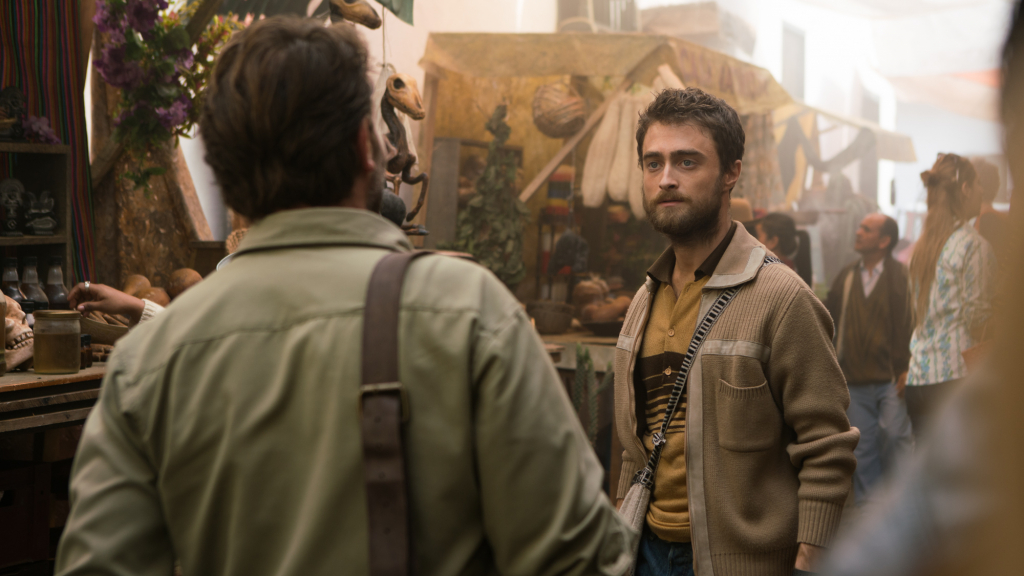
What we do have is 22-year-old protagonist Yossi Ghinsberg (Radcliffe) leaving behind his life in Israel and the expectations that he secure a career, wife and children. Trekking through South America, he meets an Austrian, Karl (Thomas Kretschmann), who offers him and his two new friends, Kevin (Alex Russell) from the US and Marcus (Joel Jackson) from Switzerland, a once-in-a-lifetime journey through the jungle. At its end, Karl claims, they will encounter an ancient civilisation that has gone more or less undiscovered by modern man, along with vast amounts of gold. They set out with only a rudimentary map and their guide’s memory for navigation – and it shouldn’t take you long to figure out what happens next.
Jungle doesn’t actually aspire to be the sort of movie that audiences might expect from a Greg McLean film about a bunch of people stuck in the Amazon … Is it a rollicking adventure tale? A gory descent into horror? A film about spiritual discovery?
Jungle has been kicking around the Australian film industry for several years, with Michael and Peter Spierig – helmers of 2014’s Predestination and last year’s Jigsaw – originally enlisted to direct; the brothers even travelled to Bolivia in 2011 to shoot preliminary footage before key financing was in place.[1]Brendan Swift, ‘Spierig Brothers Shoot Preliminary Footage for Jungle Feature in Bolivia’, IF.com.au, 4 July 2011, <http://if.com.au/spierig-brothers-shoot-preliminary-footage-for-jungle-feature-in-bolivia/>, accessed 15 October 2017. Jungle’s end credits imply that some of that footage made it into the final work, which was ultimately filmed predominantly around Mount Tamborine in Queensland. Yet, while I can certainly see what the fuss is about with regard to Ghinsberg’s story itself, I don’t think the finished product is enough to justify such a lengthy gestation period.
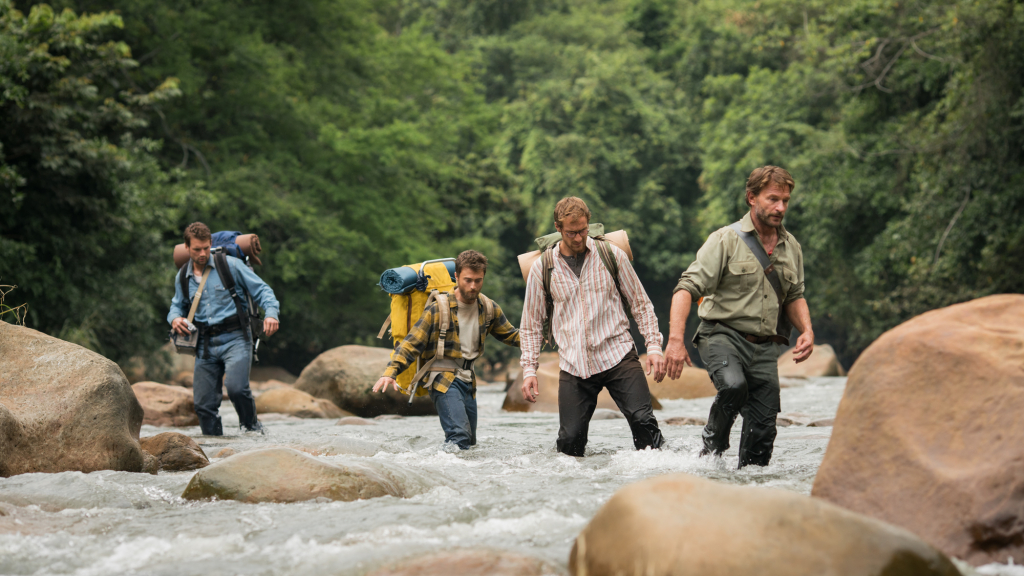
Down and out in Bolivia
Considering this is a true story – or, at least, claims to be one; I have no doubt that some parts have been embellished in the way that stories of this sort usually are – it’s a struggle to find a deeper meaning behind it. While fiction adaptations of a similar vein like The Lost City of Z (James Gray, 2016) and epic auteurist Amazon-set follies like Fitzcarraldo (Werner Herzog, 1982) have obvious colonialist themes at their centre, Jungle can’t claim any such political intrigue. If you really try, you can view McLean’s film as being about the foolishness of white man – Yossi’s Jewish ethnicity notwithstanding – and the destructiveness of Western cultures’ brutish need to conquer for no reason other than because it’s possible. Assuming this message is even meant to be there at all, it’s easy to miss it entirely.
There’s no such polemical undercurrent running through Jungle, which seems more concerned with cranial worms and quicksand … McLean’s film lacks a contextual spine to make its tale of survival rise above mere genre thrills and good performances.
Jungle would have been an altogether more interesting film had screenwriter Justin Monjo stepped away from making a faithful re-creation of Ghinsberg’s book Jungle: A Harrowing True Story of Survival, instead using its tale of a man lost in the Bolivian jungle to reflect on something bigger. That Ghinsberg’s Jewishness is not just referenced but overtly called attention to (in a flashback that is one part unnecessary, one part a curious jolt, thanks to Jacek Koman’s brief appearance as Yossi’s father) only heightens this disappointment. In particular, Jungle never draws a connection between Yossi’s desire to run away from the obligations of career and family, and the displacement of his own kin. While the image of Yossi, emaciated and smeared in mud, desperate for survival, briefly made me think of images of his ancestors in concentration camps, the film is clearly not interested in investigating any such comparisons.
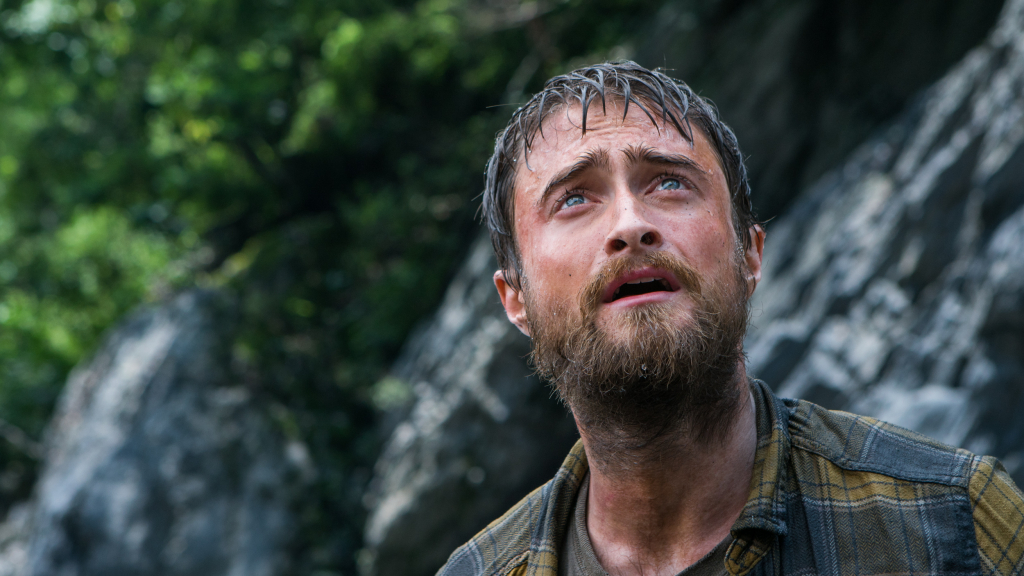
McLean has been lauded for inserting a palpable sense of political urgency in his Wolf Creek projects, which so far encompass two films (2015, 2014) and a television series. Even the nutty film sequel, with its baffling tonal shifts and heightened sense of Grand Guignol–esque horror-comedy, was – as described succinctly by critic Simon Miraudo at the time – a ‘damning satire of Australian values, particularly as we enter a renewed age of “other” fearing’. Miraudo went on to describe McLean’s work as
so brazenly anti-Australiana, it goes all the way around the bend to becoming patriotic again. Only someone this passionate about our nation, and so angry about its current direction, could make something so potent.[2]Simon Miraudo, ‘Return of the Mick – Wolf Creek 2 Review’, Quickflix, 17 February 2014, <https://www.quickflix.com.au/News/Reviews/WolfCreek2/5239>, accessed 15 October 2017.
But there’s no such polemical undercurrent running through Jungle, which seems more concerned with cranial worms and quicksand. There’s nothing wrong with depictions such as these, of course, especially when the middle act of the film is as thrilling as it is. But, while it ranks several rungs above the ridiculous horror flick Anaconda (Luis Llosa, 1997) and the limp found-footage thriller The Jungle (Andrew Traucki, 2013) in terms of showing nature-inspired terror on screen, McLean’s film nonetheless lacks a contextual spine to make its tale of survival rise above mere genre thrills and good performances.
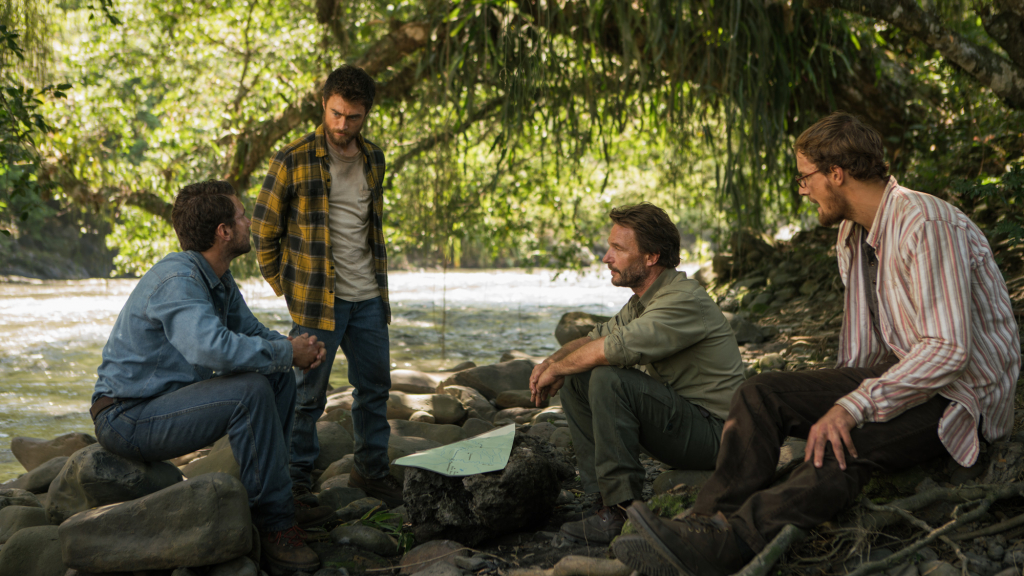
A boys’ own adventure
The McLean film that Jungle has the most in common with is Rogue (2007), which allowed the filmmaker to subsequently parlay his critical and commercial success (in Australia, at least). This earlier work is an old-fashioned monster-crocodile horror-thriller, with a comparatively large budget and a larger ensemble of recognisable actors, including Radha Mitchell, Sam Worthington, Stephen Curry and an American blow-in in the form of Michael Vartan – just to give the film a dubiously worthwhile international edge, as did so many genre efforts of the so-called Ozploitation era.
Like Rogue, Jungle works best when its cast is allowed to interact. The four main actors make a compelling combination for as long as they’re bound by the narrative to actually be together on screen. Their interactions through the first act bristle with the unique sort of tension that arises when a group of new friends spend an extended amount of time in close quarters; such relationships, which aren’t yet fully formed, are shown to easily give way to breaking tempers and shifting loyalties. The changing dynamics of their friendship – especially Jackson’s impressive portrayal of a physically depleted adventurer whose polished demeanour gradually unravels – give Jungle’s second act a particularly vibrant hum of tension, which is bolstered by beautifully photographed jungle locations and evocative sound work. But even this arc begins to become a drain on the attention span once the narrative’s focus turns to just Yossi, with the rest of the characters either disposed of or whisked to safety.
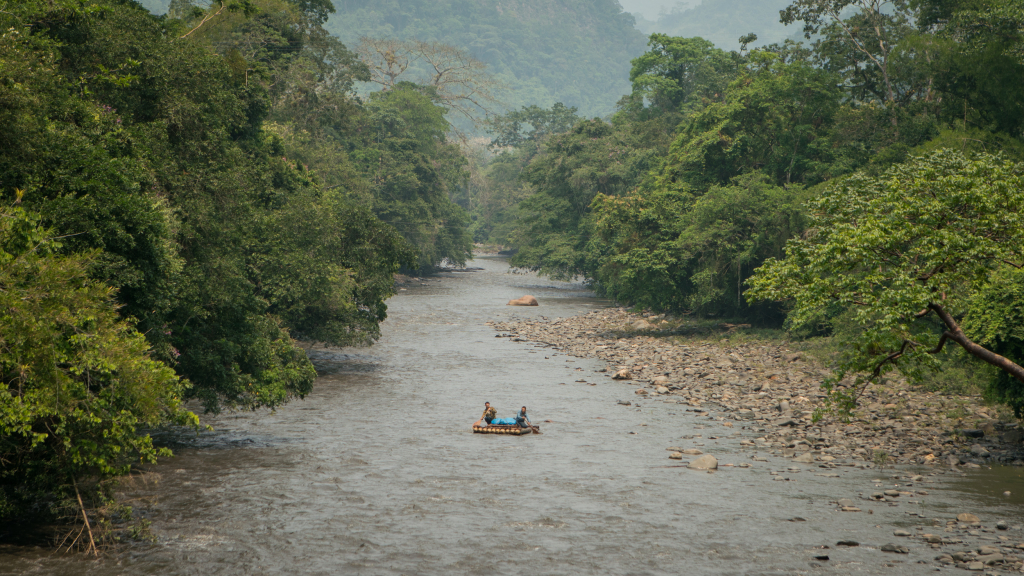
The casting of Radcliffe, still best known for his eight-film performance in the Harry Potter franchise (2001–2011), is likely to garner Jungle the same sort of curiosity factor that has accompanied most of the 28-year-old’s non-Potter acting choices, whether for screen or stage. By his own admission, Radcliffe has spent the subsequent years choosing a variety of projects: ‘My mission from when I came out of Potter was to, [with] every opportunity somebody gave me to do something different and show something different — just take it.’[3]Daniel Radcliffe, quoted in Simon Leo Brown, ‘Daniel Radcliffe Portrays Adventurer Yossi Ghinsberg in Jungle Role Far Removed from Harry Potter’, ABC News, 4 August 2017, <http://www.abc.net.au/news/2017-08-04/daniel-radcliffe-far-away-from-harry-potter-for-role-in-jungle/8771342>, accessed 15 October 2017. It’s to Radcliffe’s credit that he has stuck to this remit, even during his tenure as JK Rowling’s beloved boy wizard. The actor has demonstrated his talent and versatility, from the West End production of Peter Shaffer’s Equus and another Australian film project, the adaptation of Michael Noonan’s coming-of-age drama December Boys (Rod Hardy, 2007); to the romantic comedy What If (Michael Dowse, 2013) and fantasy-horror Horns (Alexandre Aja, 2013); to memorable roles as a farting corpse in Swiss Army Man (Daniel Kwan & Daniel Scheinert, 2016) and Allen Ginsberg in Kill Your Darlings (John Krokidas, 2013).
Much will be made of the weight loss he achieved for Jungle, usually the sort of empty attention-grabbing feat that actors resort to in an effort to prove their chops as serious thespians. But a late scene in which Radcliffe emerges from a muddy embankment, his body emaciated and barely able to hold the clothes that hang off of him, is truly powerful – aided by the fact that it’s the only scene in the film that McLean allows to be overcome by chest-pounding, lump-in-your-throat sentimentality. Despite it being an awfully convenient moment of storytelling, it’s not entirely unwelcome, given all that the audience has watched Yossi go through. And it’s particularly effective, as the final act – during which Radcliffe is often the only person on screen – lacks the propulsive force of the rest of the movie.
Star power aside, the casting of Radcliffe is smart. The actor’s lithe frame provides the character of Yossi with a fragility and even a relatability that would be otherwise unachievable had the filmmakers gone with a more traditional leading man with Hollywood-calibre muscle definition – a wildly inappropriate choice for a world-travelling Jewish backpacker in 1981. In light of the decision to adhere so closely to Ghinsberg’s story, it was wise to do so in this aspect most of all.
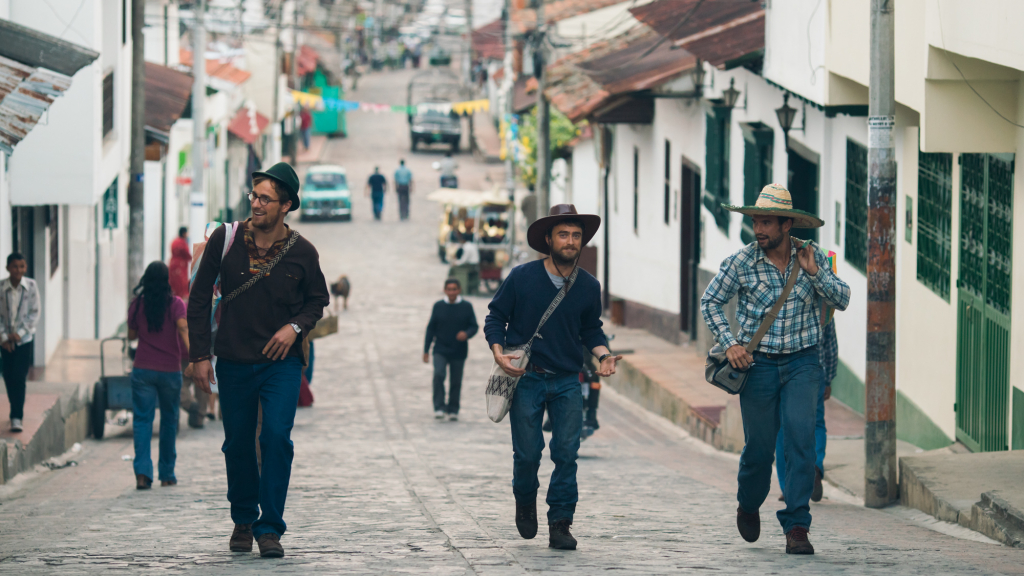
Audience drawcards
Jungle is actually one of two South America–set films directed by McLean to have found a release in 2017. The other is The Belko Experiment, a grisly, gruesome satire about the Colombian outpost of an American company whose employees are forced into a kill-or-be-killed scenario by their twisted overlords. Belko was appropriately marketed as ‘Office Space [Mike Judge, 1999] meets Battle Royale [Kinji Fukasaku, 2000]’, and was McLean’s second American production after The Darkness (2016). It may be a surprise to learn that Belko is his most consistent film since the original Wolf Creek; it’s hardly subtle, but let’s not pretend that any film wherein people are forced to kill for entertainment – Turkey Shoot (Brian Trenchard-Smith, 1982), The Hunger Games (Gary Ross, 2012) and the aforementioned Battle Royale among them – is ever particularly nuanced.
Both Belko and Jungle made their Australian debuts at the 2017 Melbourne International Film Festival (MIFF), the latter having its world premiere as the festival’s opening-night selection. McLean’s survivalist thriller is MIFF’s most mainstream opener in many years by a wide margin – perhaps a deliberate attempt to energise and invigorate its audience in ways that some of its earlier, more flat-footed selections failed to accomplish. And mainstream Jungle certainly is. It’s easy to see audiences enticed by its exotic thrills, particularly if seen on a big screen, on which its lush imagery can be best appreciated. McLean is now an established name in the local screen industries, shirking the well-worn path of genre filmmakers simply replicating their first successes. Yes, it would have been better to see the film delve more deeply into the themes it broaches – man against nature, the youthful evasion of responsibility, the selfishness of the West – but it’s nevertheless encouraging to see McLean making a film like Jungle, and doing so in Australia. The craftsmanship on display here shows he is only getting more confident as a director. Here’s hoping his next endeavour allows him to take the storytelling to the next level, too.
Endnotes
| 1 | Brendan Swift, ‘Spierig Brothers Shoot Preliminary Footage for Jungle Feature in Bolivia’, IF.com.au, 4 July 2011, <http://if.com.au/spierig-brothers-shoot-preliminary-footage-for-jungle-feature-in-bolivia/>, accessed 15 October 2017. |
|---|---|
| 2 | Simon Miraudo, ‘Return of the Mick – Wolf Creek 2 Review’, Quickflix, 17 February 2014, <https://www.quickflix.com.au/News/Reviews/WolfCreek2/5239>, accessed 15 October 2017. |
| 3 | Daniel Radcliffe, quoted in Simon Leo Brown, ‘Daniel Radcliffe Portrays Adventurer Yossi Ghinsberg in Jungle Role Far Removed from Harry Potter’, ABC News, 4 August 2017, <http://www.abc.net.au/news/2017-08-04/daniel-radcliffe-far-away-from-harry-potter-for-role-in-jungle/8771342>, accessed 15 October 2017. |
